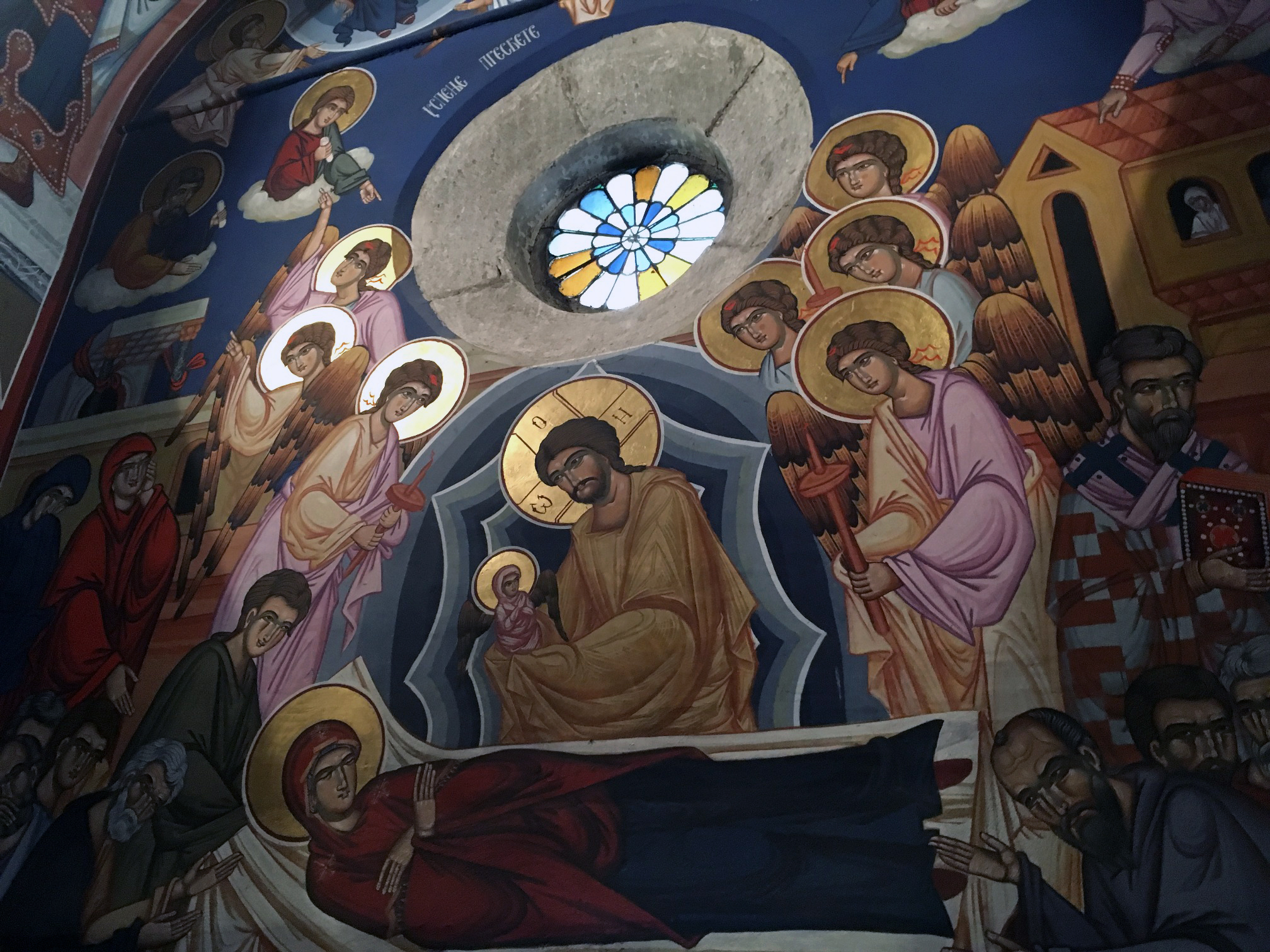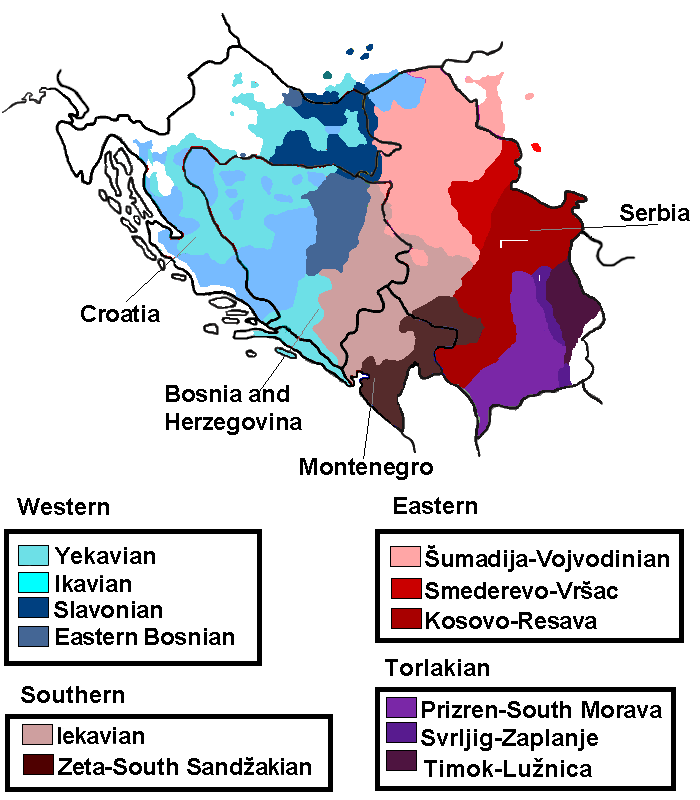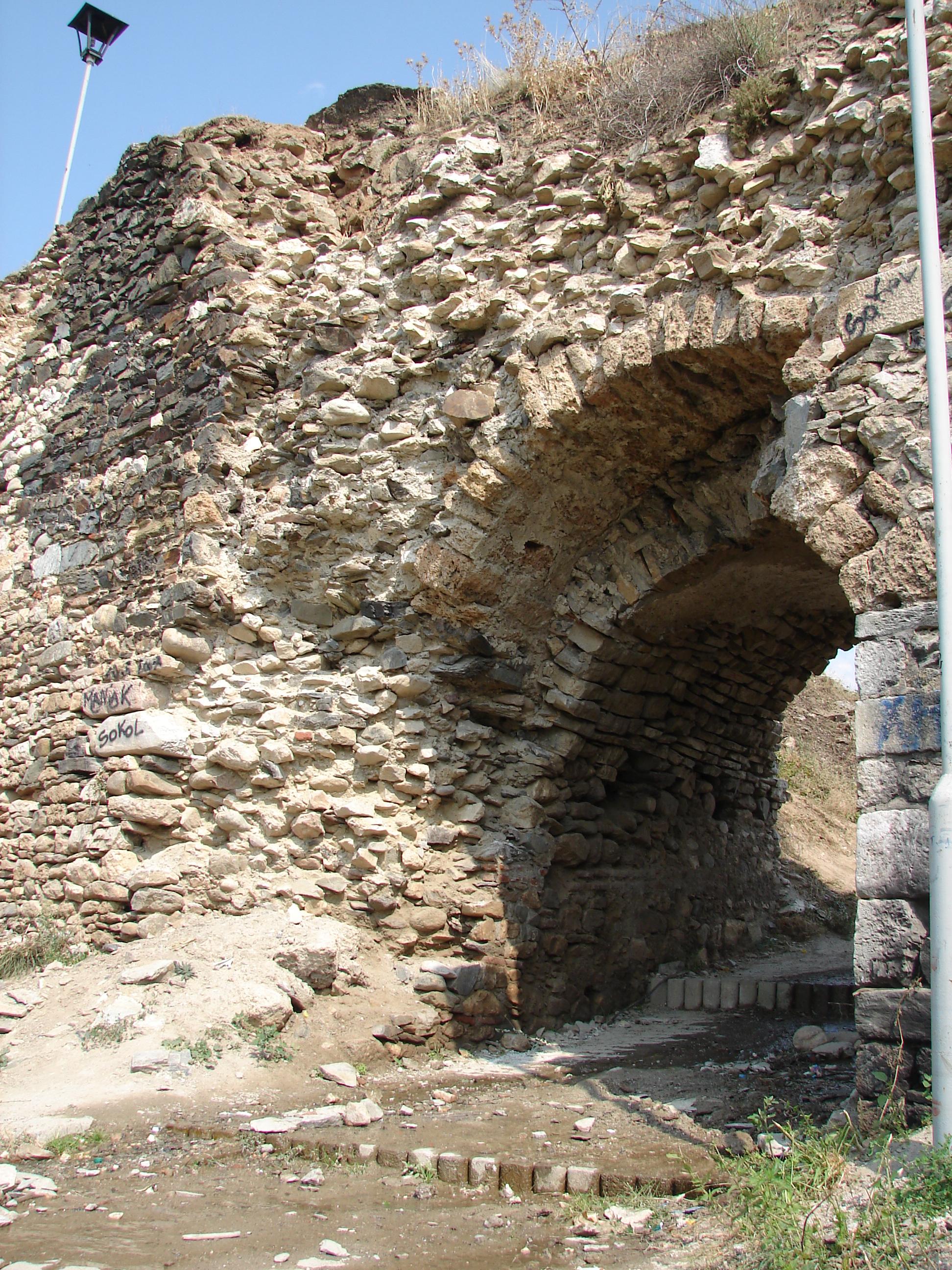|
Monastery Krka
The Krka Monastery ( sr-Cyrl, Манастир Крка, ; ) is a Serbian Orthodox monastery dedicated to the Archangel Michael, located near the river Krka, east of Kistanje, in central Dalmatia, Croatia. It is the best known monastery of the Serbian Orthodox Church in Croatia and it is officially protected as part of the Krka National Park. It was established around 1577 or later on the ground of previous Gothic- Romanesque style Catholic church. History The monastery was built on top of an Ancient Roman site. Roman burial catacombs, Romanesque belfry, Gothic window and other parts of the building (including graves), show that the Orthodox monastery was previously home to a late medieval Catholic church or monastery (c. 14th century), whose architectural style was uncommon for the Serbian-Byzantine Orthodox churches of the time. According to most recent synthesis of archaeological, architectural, conservation-restoration research, the monastery's church had three buildin ... [...More Info...] [...Related Items...] OR: [Wikipedia] [Google] [Baidu] |
Serbian Orthodox
The Serbian Orthodox Church ( sr-Cyrl-Latn, Српска православна црква, Srpska pravoslavna crkva) is one of the autocephalous (ecclesiastically independent) Eastern Orthodox Christian churches. The majority of the population in Serbia, Montenegro and Republika Srpska of Bosnia and Herzegovina are baptised members of the Serbian Orthodox Church. It is organized into metropolitanates and eparchies, located primarily in Serbia, Bosnia and Herzegovina, Montenegro, and Croatia. Other congregations are located in the Serb diaspora. The Serbian Patriarch serves as first among equals in his church. The current patriarch is Porfirije, enthroned on 19 February 2021. The Church achieved autocephalous status in 1219, under the leadership of Saint Sava, becoming the independent Archbishopric of Žiča. Its status was elevated to that of a patriarchate in 1346, and was subsequently known as the Serbian Patriarchate of Peć. This patriarchate was abolished by ... [...More Info...] [...Related Items...] OR: [Wikipedia] [Google] [Baidu] |
Šubić Family
The Šubić family, also known initially as Bribirščić (Berberistich, Broborstic, Breberstic, Breberienses), was one of the Twelve noble tribes of Croatia and a great noble house which constituted Croatian statehood in the Middle Ages. They held the county of Bribir (Dalmatia), Bribir (''Varvaria'') in inland Dalmatia. They with their prominent branch Zrinski family, Zrinski (1347–1703) were arguably the leading noble family of Croatia for almost 500 years. History Origins Today Bribir (Skradin), Bribir is an archaeological site in inland Dalmatia. It is located on a flat hill about fifteen kilometres northwest of Skradin, near the old Zadar road which goes through Benkovac. Under the steep rocks of its western side there is the source of the Bribirčica stream and from here the rich and fertile Bribir-Ostrovica field spreads out. The hill of Bribir, an ideal place to control the surrounding territory, was a perfect area to inhabit. The one who held it had control over all ... [...More Info...] [...Related Items...] OR: [Wikipedia] [Google] [Baidu] |
Greater Serbian
The term Greater Serbia or Great Serbia () describes the Serbian nationalist and irredentist ideology of the creation of a Serb state which would incorporate all regions of traditional significance to Serbs, a South Slavic ethnic group, including regions outside modern-day Serbia that are partly populated by Serbs. The initial movement's main ideology (Pan-Serbism) was to unite all Serbs (or all territory historically ruled, seen to be populated by, or perceived to be belonging to Serbs) into one state, claiming, depending on the version, different areas of many surrounding countries, regardless of non-Serb populations present. The Greater Serbian ideology includes claims to various territories aside from modern-day Serbia, including the whole of the former Yugoslavia except Slovenia and part of Croatia. According to Jozo Tomasevich, in some historical forms, Greater Serbian aspirations also included parts of Albania, Bulgaria, Hungary and Romania. Its inspiration comes from the ... [...More Info...] [...Related Items...] OR: [Wikipedia] [Google] [Baidu] |
Nikodim Milaš
Nikodim Milaš ( sr-cyr, Никодим Милаш), born Nikola Milaš, (16 April 1845 – 2 April 1915), was a Serbian Orthodox Church bishop, theologian, university professor and academic. He was a writer, one of the most respected experts on Eastern Orthodox canon law, and less on church history. As a canon lawyer in Dalmatia, he defended the Serbian Orthodox Church against the state. He was an academic and polyglot. Milaš authored a number of books, including the criticized ''Orthodox Dalmatia'' (1901). His bibliography reportedly includes more than 180 works. Beyond his work in canonical and ecclesiastical law, he was dedicated to countering Catholic proselytism and state efforts which downplayed the Serbian Orthodox heritage. He was one of the founders of the Serb Party in Dalmatia and served in the Diet of Dalmatia (1889-1901). However, in some of his historiographical writings, he portrayed the two denominations in a simplistic manner and fabricated certain historical s ... [...More Info...] [...Related Items...] OR: [Wikipedia] [Google] [Baidu] |
Eparchy Of Dalmatia
The Eparchy of Dalmatia ( or ) is a diocese or eparchy of the Serbian Orthodox Church, having jurisdiction over the region of Dalmatia, in Croatia. Since 2017, Serbian Orthodox Bishop of Dalmatia is Nikodim Kosović. History Between Venetian and Turkish Rule Under French and Austrian Rule Dalmatia in Yugoslavia Modern Times Bishops * Nikodim Busović (1693—1705), as bishop of Krka * Savatije Ljubibratić (1705—1716) * Stevan Ljubibratić (1716–1722) * Simeon Končarević (1751—1762) * Venedikt Kraljević (1810—1823) *Josif Rajačić (1829—1834) * Pantelejmon Živković (1834— 1836) * Jerotej Mutibarić (1843—1853) * Stefan Knežević (1853—1890) * Nikodim Milaš (1890—1910) * Dimitrije Branković (1913—1920) * Danilo Pantelić (1921—1927) * Maksimilijan Hajdin (1928—1931) * Irinej Đorđević (1931—1952) * Nikanor Iličić (1947—1951) * Simeon Zloković (1951—1959) * Stefan Boca (1959—1978) *Nikolaj Mrđa (1978—1992) * Longin Krč ... [...More Info...] [...Related Items...] OR: [Wikipedia] [Google] [Baidu] |
Vjesnik
''Vjesnik'' () was a Croatian state-owned daily newspaper published in Zagreb. Originally established in 1940 as a wartime illegal publication of the Communist Party of Croatia, it later built and maintained a reputation as Croatia's newspaper of record during most of its post-war history. It ceased publication in April 2012. "Tiskara Vjesnik" and "Vjesnik d.d." were the namesakes of the ''Vjesniks printing office and publishing house, respectively. During World War II and the Nazi-allied Independent State of Croatia regime which controlled the country, the paper served as the primary media publication of the Yugoslav Partisans movement. The August 1941 edition of the paper featured the statement "'' Smrt fašizmu, sloboda narodu''" () on the cover, which was afterwards accepted as the official slogan of the entire resistance movement and was often quoted in post-war Yugoslavia. Its heyday was between 1952 and 1977 when its Wednesday edition (''Vjesnik u srijedu'' or VUS) reg ... [...More Info...] [...Related Items...] OR: [Wikipedia] [Google] [Baidu] |
Miroslav Krleža Institute Of Lexicography
The Miroslav Krleža Institute of Lexicography ( or LZMK) is Croatia's national lexicographical institution. Based in Zagreb, it was established in 1950 as the national lexicographical institute of the Socialist Federal Republic of Yugoslavia. It was renamed after its founder, the Croatian writer Miroslav Krleža, in 1983. History The institute was founded in 1950 as the Lexicographical Institute of the Federal People's Republic of Yugoslavia (''Leksikografski zavod FNRJ'') and was renamed the Yugoslav Lexicographical Institute (''Jugoslavenski leksikografski zavod'', ''JLZ'') in 1962. The institution was originally established as a federal body under de facto responsibility of the Federal Executive Council while its “founding rights” were relegated to the Socialist Republic of Croatia in 1970s. Its longtime director was writer Miroslav Krleža, with Mate Ujević as the chief editor. It was based in Zagreb, with branches in Ljubljana and Belgrade. The office in Belgra ... [...More Info...] [...Related Items...] OR: [Wikipedia] [Google] [Baidu] |
Bribir (Skradin)
Bribir is the name of two villages in Croatia Croatia, officially the Republic of Croatia, is a country in Central Europe, Central and Southeast Europe, on the coast of the Adriatic Sea. It borders Slovenia to the northwest, Hungary to the northeast, Serbia to the east, Bosnia and Herze ...: * Bribir, Primorje-Gorski Kotar County * Bribir, Šibenik-Knin County ** ''Bribir'' is used as a reference to the historic seat of the House of Šubić {{geodis ... [...More Info...] [...Related Items...] OR: [Wikipedia] [Google] [Baidu] |
Skradin
Skradin is a small town in the Šibenik-Knin County of Croatia. It is located near the Krka (Croatia), Krka river and at the entrance to the Krka National Park, from Šibenik and from Split, Croatia, Split. The main attraction of the park, Slapovi Krke, is a series of waterfalls, the biggest of which, Skradinski buk, was named after Skradin. History During Classical antiquity, Antiquity, the city was known as ''Scardon'' and ''Scardona'', a name attested in the writings of Strabo and Procopius (), Pliny the Elder () and Ptolemy (). Before the Roman Empire, Roman conquest, the settlement was Illyrians, Illyrian, with the particularity of having the locally recurring suffix ''-ona''. The prevailing theory links the root of the Illyrian toponym to a term meaning "steep", as a derivation of ''*sko/ard(h)-'', and it has been compared with the Šar mountains, Scardus mountains in southern Illyria. p. 363. After an initial development in Vulgar Latin in the form ''-una'', the Illyrian ... [...More Info...] [...Related Items...] OR: [Wikipedia] [Google] [Baidu] |
Mladen III Šubić Bribirski
Mladen () is a South Slavic masculine given name, derived from the Slavic root ''mlad'' (, ), meaning "young". It is present in Bosnian, Slovenian, Montenegrin, Macedonian, Bulgarian, Serbian, and Croatian society since the Middle Ages. Notable people with the name include: * Mladen (vojvoda) ( 1323–26), Serbian magnate * Mladen I Šubić (d. 1304), Croatian nobleman, member of the Šubić family of Bribir * Mladen II Šubić (1270–1343), Croatian nobleman, member of the Šubić family of Bribir * Mladen III Šubić (c. 1315–1348), Croatian nobleman, member of the Šubić family of Bribir * Mladen Bartolović, Bosnian footballer * Mladen Dolar, Slovenian philosopher * Mladen Erjavec, Croatian basketball coach * Mladen Krstajić, Serbian footballer * Mladen Milicevic, composer of music * Mladen Petrić, Croatian footballer * Mladen Plakalović, Bosnian cross-country skier * Mladen Rudonja, Slovenian footballer * Mladen Šekularac, Montenegrin basketball pla ... [...More Info...] [...Related Items...] OR: [Wikipedia] [Google] [Baidu] |
Stefan Dušan
Stephen (honorific), Stefan Uroš IV Dušan ( sr-Cyrl, Стефан Урош IV Душан), also known as Dušan the Mighty ( sr-Cyrl, Душан Силни; – 20 December 1355), was the King of Serbia from 8 September 1331 and Emperor of the Serbs, Emperor of the Serbs, Greeks, Bulgarians and Albanians from 16 April 1346 until his death in 1355. Dušan is considered one of the greatest medieval Balkan conquerors. Dušan conquered a large part of southeast Europe, becoming one of the most powerful monarchs of the era. Under Dušan's rule, Serbia was the most powerful state in Southeast Europe and one of the most powerful European states. It was an Eastern Orthodoxy, Eastern Orthodox, multi-ethnic, and multilingual empire that stretched from the Danube in the north to the Gulf of Corinth in the south, with its capital in Skopje. He enacted the constitution of the Serbian Empire, known as Dušan Code, perhaps the most important List of medieval Serbian literature, literary work ... [...More Info...] [...Related Items...] OR: [Wikipedia] [Google] [Baidu] |
Serbian Empire
The Serbian Empire ( sr-Cyrl-Latn, Српско царство, Srpsko carstvo, separator=" / ", ) was a medieval Serbian state that emerged from the Kingdom of Serbia. It was established in 1346 by Dušan the Mighty, who significantly expanded the state. During Dušan's rule, Serbia was one of the most powerful European states and, the most powerful in Southeast Europe. It was an Eastern Orthodox multi-ethnic and multi-lingual empire that stretched from the Danube in the north to the Gulf of Corinth in the south, with its capital in Skopje. Dušan also promoted the Serbian Archbishopric to the Serbian Patriarchate. In the Serbian Empire, the region of Kosovo was the most prosperous and densely populated area, serving as a key political, religious, and cultural center. Dušan's son and successor, Uroš the Weak, struggled to maintain his father's vast empire, gradually losing much of the conquered territory - hence his epithet. The Serbian Empire effectively ended wit ... [...More Info...] [...Related Items...] OR: [Wikipedia] [Google] [Baidu] |






